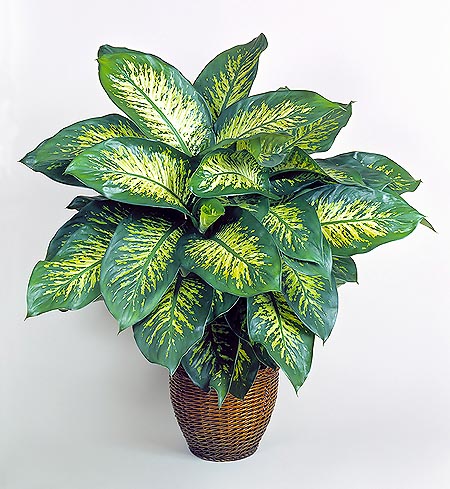Family : Araceae

Text © Pietro Puccio

English translation by Mario Beltramini

Excellent indoor plant, but beware of its toxic sap © Giuseppe Mazza
The Dieffenbachia seguine (Jacq.) Schott (1829) is native to North America (Mexico), Central America (Costa Rica, El Salvador, Guatemala, Honduras and Nicaragua), South America (Bolivia, Brazil, Colombia, Ecuador, French Guyana, Guyana, Surinam and Venezuela) and to the Caribbean (Antigua and Barbuda, Dominica, Grenada, Guadeloupe, Martinique, Puerto Rico, St. Lucia, St. Vincent and the Grenadines, Trinidad and Tobago), where it grows in swampy zones and in humid forests.
The genus is honoured to the German physician Johann Friedrich Dieffenbach (1792-1847); the name of the species is of uncertain origin.
Common names: “dieffenbachia”, “dieffenbachia gigante” (Italian); “dieffenbachia”, “dumb cane”, “dumbplant”, “giant dumbcane”, “spotted dumbcane”, “leopard lily”, “galatea”, “mother-in-law plant” (English); “canne à gratter”, “canne du muet”, “dieffenbachée”, “plant des sourds-muets” (French); “cana-de-Imbé”, “comigo-ninguém-pode” (Portuguese); “aro seguino”, “caña muda”, “chucha”, “diefembaquia”, “millonaria” (Spanish); “Schweigrohrwurzel” (German).
Evergreen perennial herbaceous, it forms erect stems of about 3 cm of diameter and long up to about 2 m, and even more when in its natural habitat, on which are visible the rings left by the foliar bases, alternate leaves, on a petiole long about 30 cm, lance-shaped, or oblong, with sharp apexes, 20-50 cm long and 10-20 cm broad, of an intense glossy green colour, dotted and spotted of white or creamy colour. The axillar inflorescences, in groups of 2-3, are formed by an about 16 cm long spadix, contained in a greenish-white spathe, long about 20 cm, the flowers are unisexual and protogenous (the female flowers are receptive before the ripening of the male ones, thus avoiding the self-fecundation), in particular the male flowers occupy the upper part of the spadix, the female ones are grouped in the lower part and are separated from the male ones by a sterile zone. The fruits are orange red berries.
Usually, it reproduces by apical cutting, air layering or parts of stem, with at least three knots, placed vertically or interred horizontally for a half, or little more, of its thickness.
The plant is cultivable in open spaces in the humid tropical climate zones in a very luminous position, in order to exalt the variegation of its leaves, but far from the direct sun, on soils rich of organic substance, draining and ventilated, rather acid; elsewhere, it is to be cultivated in pot and as such it is much appreciated for indoor decoration thanks to its highly ornamental foliage.
The substratum must be organic, with addition of sand or agriperlite, porous and well drained in order to avoid rottenness to the roots.
The temperature must be kept over the 14-16 °C, better around 20-22 °C, without sudden variations. During the vegetative period the watering must be regular and the substratum is to be kept humid, but without stagnations, which can cause foliar yellowing, during the winter watering are to be done less frequently, especially if the temperatures are close to the lower limit, but without allowing the substratum to dry up completely.
All the parts of the plant contain toxic substances, in particular calcium oxalate, which can cause reactions, even serious; the sap can make skin, eyes problems, causing burns and opacity of the cornea for some days, irreversible in some cases, irritation to the mouth mucosae, edema of the glottis, with suffocation, and inflammation of the larynx with loss of speaking capacity for several days; the most common name in English, dumb cane (the cane of the dumb) refers to this and probably to the utilization which seems it was done to punish at times the slaves, placing some fragments of it in their mouths.
Therefore, all operations being done on the plant are to be effected with caution, utilizing gloves in order to avoid the direct contact of the sap with the skin, paying great care not to touch mouth and eyes, and the presence of the plant in locations where kids or animals are, is to be avoided, as they can chew and swallow parts of same.
Synonyms: Dieffenbachia amoena hort.; Arum seguine Jacq. (1760); Arum seguinum L. (1763); Caladium seguinum (Jacq.) Vent. (1801); Caladium maculatum Lodd. (1822); Dieffenbachia maculata (Lodd.) G. Don (1839); Dieffenbachia liturata Schott (1852); Dieffenbachia picta Schott (1852); Dieffenbachia plumieri Schott (1852); Dieffenbachia lineata K. Koch & C.D. Bouché (1853); Dieffenbachia robusta K. Koch (1853); Dieffenbachia cognata Schott (1856); Dieffenbachia consobrina Schott (1856); Dieffenbachia poeppigii Schott (1856); Dieffenbachia gollmeriana Schott (1858); Dieffenbachia neglecta Schott (1859); Dieffenbachia ventenatiana Schott (1859); Dieffenbachia irrorata Schott (1860); Dieffenbachia lingulata Schott (1860); Dieffenbachia barraquiniana Verschaff. & Lem. (1864); Dieffenbachia conspurcata Schott (1864); Dieffenbachia gigantea Verschaff. (1866); Dieffenbachia wallisii Linden (1870); Dieffenbachia brasiliensis Veitch (1875); Dieffenbachia picta fo. brasiliensis (Veitch) Engl. (1878); Dieffenbachia seguine fo. barraquiniana (Verschaff. & Lem.) Engl. (1878); Dieffenbachia seguine fo. conspurcata (Schott) Engl. (1878); Dieffenbachia seguine fo. irrorata (Schott) Engl. (1878); Dieffenbachia seguine fo. lineata (K. Koch & C.D. Bouché) Engl. (1878); Dieffenbachia seguine fo. liturata (Schott) Engl. (1878); Dieffenbachia seguine var. lingulata (Schott) Engl. (1878); Dieffenbachia magnifica Linden & Rodigas (1883); Dieffenbachia picturata L. Linden & Rodigas (1892); Dieffenbachia picta subvar. gigantea (Verschaff.) Engl. (1899); Dieffenbachia picta subvar. picturata (L. Linden & Rodigas) Engl. (1899); Dieffenbachia seguine subvar. barraquiniana (Verschaff. & Lem.) Engl. (1899); Dieffenbachia seguine subvar. irrorata (Schott) Engl. (1899); Dieffenbachia seguine subvar. lineata (K. Koch & C.D. Bouché) Engl. (1899); Dieffenbachia seguine subvar. lingulata (Schott) Engl. (1899); Dieffenbachia seguine subvar. liturata (Schott) Engl. (1899); Dieffenbachia seguine subvar. ventenatiana (Schott) Engl. (1899); Dieffenbachia seguine var. robusta (K. Koch) Engl. (1899); Dieffenbachia picta var. barraquiniana (Verschaff. & Lem.) Engl. (1915); Dieffenbachia seguine subvar. irrorata (Schott) Engl. (1915); Dieffenbachia seguine subvar. wallisii (Linden) Engl. (1915); Dieffenbachia seguine var. liturata (Schott) Engl. (1915); Dieffenbachia seguine var. ventenatiana (Schott) Engl. (1915); Dieffenbachia maculata (Lodd.) G.S. Bunting (1963).
